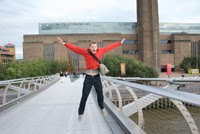I have been back at Edinburgh College of Art (ECA) for four weeks now. We, here in the Product Design department, have been working on methods of research for our projects. The course is set up so that we are all doing similar things throughout the different years so that we can see what other people are doing and learn from them.
I am in my final year at ECA and for this year we have had to come up with an 'area of interest' to pursue for the entire year. My area of interest, I have named
Adaptive Spaces. This is about adapting space to best suit our needs. The course is broken down into four sections: Find, Play, Make and Talk. Find is basically research, this is the area that I am currently working on. Play is about coming up with concepts and making models. Make is producing the final prototype. Talk is about getting people involved and convinced about your idea.
To find out more about my project go to 'CURRENT'.
The main method of research we are covering at the moment is 'Cultural Probes' or to avoid possible innuendo, 'Cultural Stimuli'. This is a strategy that has come about in recent years in order to get the user much more involved in the design process, with the hopeful outcome, to produce products that are actually needed and useful. An example of a really useful cultural probe is a camera used by the market to take photographs showing aspects of their lives. This allows researchers to unintrusively enter into peoples homes, work etc and see what are the real areas for improvement, not just those that they assume are.
'What I really want is to design for you.'
My project is based around adapting to spaces, or creating spaces which adapt to the needs of the user, however what I really want is to design for you. I have set up a number of simple web based probes to try and target the different areas of your lives that I think relate to my project. I understand as much as anyone how busy our lives can be, but also that although we may not think so there is time in the day to do things if we just do them. I have constructed the web probes in sections so that they can be slotted in to your daily lives, perhaps one a day. You can answer them in several ways:
- Answer the questions and do the tasks as and when you find them, there and then.
- Or else write the questions down the night before, or first thing in the morning and make note of things through the day when you come across them. This is the preferred method as it will almost certainly bring up things that you wouldn't think of if you simply sat down and did it.
If you complete a web probe (or perhaps I should say Wobe in todays ocean of digital abbreviations,) and you think of something else that you didn't add, please just go back onto the wobe you were thinking of and fill in the section again with your new findings. As long as you put the same name and email address I can recognise it as you and keep all your info together.
Help me design for you. Look around you, everything you see has been designed to some extent. This is your chance to help me change the world for the better.
Go to Wobes - Click Here.

